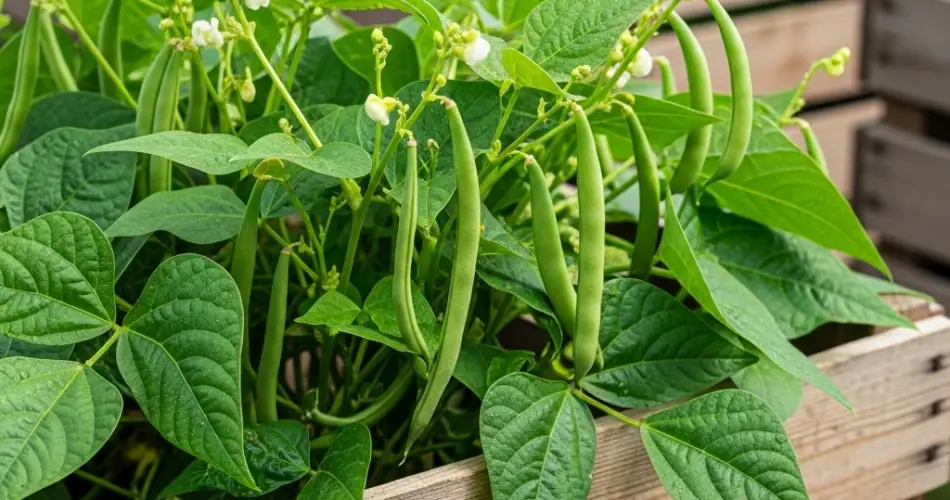Beans are one of the easiest and most satisfying vegetables to grow, especially when space is limited. With just a few wooden crates, you can cultivate a thriving bean garden right in your backyard. Crate beds are ideal for small gardens or urban settings where traditional ground planting isn’t possible. They offer excellent drainage, good soil control, and portability—perfect for growing healthy, productive bean plants.
Whether you’re aiming for green beans, string beans, or snap beans, crate gardening lets you enjoy homegrown produce with minimal fuss. Here’s how to turn a simple wooden crate into a bean-growing machine.
Why Grow Beans in Crates?
Beans adapt well to containers, and crate beds provide the space they need to spread and climb. These beds are perfect for controlling soil quality, preventing weed invasions, and minimizing soil-borne diseases. Crates also offer flexibility—you can place them where sunlight is best and even move them if needed.
For gardeners without access to open land, crate beds make it easy to create a mini-vegetable plot. They also bring height and definition to your backyard, making your space both functional and attractive.
Selecting the Right Crate
Choose a wooden crate that’s at least 12 inches deep and wide enough to accommodate multiple plants. Beans have moderate root systems that need space to spread, and bush varieties require more surface area, while climbing types will need vertical support.
Make sure your crate has drainage holes. If not, drill several at the base to allow excess water to escape. To line the crate, use landscape fabric, burlap, or breathable cloth that holds the soil while allowing drainage.
If the crate will sit directly on the ground, elevating it with bricks or blocks can improve airflow and reduce rot on the wood.
Soil Preparation
Beans thrive in well-draining, fertile soil. For crate gardening, use a lightweight growing mix:
-
2 parts organic potting soil
-
1 part compost
-
1 part perlite or coarse sand for drainage
Beans fix their own nitrogen, so you don’t need a lot of nitrogen-rich fertilizer. Instead, add a balanced slow-release organic fertilizer before planting to support early growth. Avoid heavy manures or nitrogen-rich amendments, as too much nitrogen can promote leaves over pods.
Choosing Bean Varieties
You can grow two main types of beans in crates:
-
Bush Beans – Compact, low-maintenance plants that don’t need support. Great for smaller crates and faster harvests.
-
Pole Beans – Vining types that climb. These require a trellis or stakes but yield more over a longer period.
Popular bush varieties include ‘Provider’, ‘Contender’, and ‘Blue Lake’. For pole beans, ‘Kentucky Blue’ and ‘Scarlet Runner’ are favorites.
Planting Beans in Crate Beds
Beans grow best from direct seeding rather than transplanting. After the last frost, sow seeds directly into the crate soil.
For bush beans:
-
Plant seeds 2 inches apart in rows spaced 6 inches apart.
-
Thin seedlings to 4 inches apart once they sprout.
For pole beans:
-
Space seeds 3–4 inches apart near the base of a support structure such as bamboo stakes, string trellis, or a tomato cage.
Press seeds about 1 inch deep into the soil and water thoroughly.
Care and Maintenance
-
Watering: Keep the soil evenly moist, especially during flowering and pod development. Avoid overwatering—beans dislike soggy soil.
-
Sunlight: Place crates where plants receive at least 6–8 hours of full sunlight daily.
-
Support: For pole beans, install supports early. You can use wooden stakes, a teepee structure, or a crate-mounted trellis.
-
Feeding: Once beans start producing pods, a light feeding of compost tea or diluted liquid fertilizer can help extend productivity.
Mulching with straw or dry leaves helps retain moisture and suppress weeds.
Common Pests and Problems
Beans are relatively low-maintenance, but be on the lookout for:
-
Aphids – Spray off with water or apply insecticidal soap.
-
Bean Beetles – Handpick or use neem oil spray.
-
Powdery Mildew – Ensure good air circulation and avoid overhead watering.
Regular inspection and prompt action keep issues from spreading.
Harvesting Your Beans
Most bush beans are ready for harvest about 50–60 days after planting. Pole beans take slightly longer but continue producing for weeks.
Pick beans when they are young, crisp, and tender. Don’t let pods over-mature, as they become tough and signal the plant to stop producing.
Harvest regularly to encourage continued pod development. Use scissors or gently pinch the pods to avoid damaging the stems.
Final Tips
-
Rotate your bean crop each season to avoid soil exhaustion and disease buildup.
-
After the season ends, you can compost the plants or chop them and mix them into the soil—they’re nitrogen fixers and will improve soil fertility.
-
Beans grow well alongside carrots, cucumbers, or even radishes—making them great for mixed crate beds.
Conclusion
Backyard crate beds offer a simple and productive solution for growing your own beans. Whether you’re an experienced gardener or just starting out, beans are forgiving and highly rewarding. With basic materials, a little sunshine, and regular care, you’ll be harvesting handfuls of crisp, flavorful beans in no time. Plus, your repurposed crates turn into rustic garden features that fit beautifully into any small space or backyard setup.



